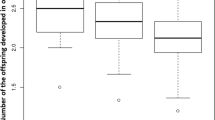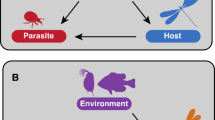Summary
The extent, magnitude, and cause of natural covariation between degree of parasitism and other variables known or suspected of influencing host fitness (such as host age or body size) has been understudied. We demonstrate that degree of parasitism by larval water mites (Arrenurus spp.) was associated with reduced condition of males and with lowered fecundity of young females of the damselfly, Enallagma ebrium (Hagen) (Odonata: Coenagrionidae). We also demonstrate that degree of parasitism can covary with both age and size of host damselflies. We explain the putative causes of such natural covariation, and we suggest that degree of parasitism, host age, and host size can all interact to determine damselfly fitness. We expect that natural covariation between the host's phenotype and degree of parasitism will be frequently observed. Studies of such natural covariation will help researchers to assess better the importance of several variables on host reproductive success and to understand better the dynamics of host-parasite interactions.
Similar content being viewed by others
References
Åbro A (1982) The effects of parasitic water mite larvae (Arrenurus spp.) on zygopteran imagoes (Odonata). J Invertebr Pathol 39:373–381
Baker RL (1989) Condition and size of damselflies: a field study of food limitation. Oecologia 81:111–119
Banks MJ, Thompson DJ (1985) Lifetime mating success in the damselfly, Coenagrion puella. Anim Behav 33:1175–1183
Banks MJ, Thompson DJ (1987) Lifetime reproductive success of females of the damselfly Coenagrion puella. J Anim Ecol 56:815–832
Barlett CM, Anderson RC (1987) Pelecitus fulicaetrae (Nematoda: Filaroidea) of coots (Gruiformes) and grebes (Podicipediformes): Skin-inhabiting microfilariae and development in Mallophaga. Can J Zool 65:2803–2812
Blower SM, Roughgarden J (1988) Parasitic castration: hostspecies preferences, size selectivity and spatial heterogeneity. Oecologia 75:512–515
Borgia G, Collis K (1989) Female choice for parasite-free male satin bowerbirds and the evolution of bright male plumage. Behav Ecol Sociobiol 25:445–454
Clutton-Brock TH (1988). Reproductive success. In: TH Clutton-Brock (ed) Reproductive success: studies of individual variation in contrasting breeding systems. University of Chicago Press. pp 472–485
Crespi B (1989) Causes of assortative mating in arthropods. Anim Behav 38:980–1000
Fincke OM (1988) Sources of variation in lifetime reproductive success in a nonterritorial damselfly (Odonata: Coenagrionidae). In: Clutton-Brock TH (ed) Reproductive success: studies of individual variation in contrasting breeding systems. University of Chicago Press. pp 24–43
Folstad I, Nilssen AC, Halvorson O and Anderson J (1989) Why do male reindeer (Rangifer t. tarandus) have higher abundance of second and third instar larvae of Hypoderma tarandi than females? Oikos 55:87–92
Forbes MRL, Baker RL (1990) Susceptibility to parasitism: experiments with damselflies (Enallagma ebrium; Coenagrionidae) and larval water mites (Arrenurus spp.; Acari) Oikos 58:61–66
Forsyth A, Montgomerie RD (1987) Alternative reproductive tactics in the territorial damselfly Calopteryx maculata: sneaking by older males. Behav Ecol Sociobiol 21:73–81
Gill DE, Mock BA (1985) Ecological and evolutionary dynamics of parasites: The case of Trypanosoma diemyctyli in the redspotted newt, Notophthalmus viridescens. In: Rollinson D, Anderson RM (eds). Ecology and genetics of host-parasite interactions. Linnaean Society of London, pp 157–183
Hinnekint BON (1987) Population dynamics of Ischnura E. elegans (Vander Linden) (Insecta: Odonata) with special reference to morphological colour changes, female polymorphisms, multiannual cycles, and their influence on behaviour. Hydrobiologia 146:3–31
Hyashi K (1985) Alternative mating strategies in the water strider Gerris remigis (Heteroptera, Gerridae) Behav Ecol Sociobiol 16:301–306
Johnson DM, Bohanan RE, Watson CN, Martin TH (1984) Coexistence of Enallagma divagans and E. traviatum (Zygoptera: Coenagrionidae) in Bays Mountain Lake, Tennessee: an in situ enclosure experiment. In: Pritchard G (ed) Advances in Odonatology. University of Calgary Press, Calgary, pp 57–70
Juliano S (1985) The effects of body size on mating and reproduction in Brachinus lateralis (Coleoptera: Carabidae). Ecol Entomol 10:271–280
Lanciani CA (1983) Overview of the effects of water mite parasitism on aquatic insects. In: Hoy M, Cunningham G, Knutson L (eds). Research needs for development of biological control of pests by mites. Univ. California Agricultural Experimental Station Special Publication 3304:86–90
McLachlan A (1989) Animal populations at extreme densities: size dimorphism by frequency dependent selection in ephemeral habitats. Funct Ecol 3:633–643
McLachlan A, Neems R (1989) An alternative mating system in small insects. Ecol Entomol 14:85–91
McVey ME (1988) The opportunity for sexual selection in a territorial dragonfly, Erythemis simplicollis. In: Clutton-Brock TH (ed) Reproductive success: studies of individual variation in contrasting breeding systems. University of Chicago Press. pp 44–58
Mitchell R (1959) Life histories and larval behaviour of Arrenurid water mites parastizing Odonata. J New York Ent Soc 1:1–12
Mitchell R (1967) Host exploitation by two closely-related water mites. Evolution 21:59–75
Mitchell R (1968) Site selection by larval water mites parasitic on the damselfly Cercion hieroglyphicum Brauer. Ecology 49:40–47
Münchberg P (1982) On the parasitism on the wings of Sympetrum meridionale and S. fonscolombei Selys by Arrenurus papillator. Arch fur Hydrobiologie 95:229–316
Pianka ER (1988) Evolutionary ecology, fourth edition. Harper and Row, Publishers, Inc., NY
Pianka ER, Parker WS (1975) Age-specific reproductive tactics. Am Nat 109:453–464
Price PW (1980) Evolutionary biology of parasites. Princeton NY, Princeton University Press
Robinson JV (1983) Effects of water mite parasitism on the demographics of an adult population of Ischnura posita (Hagen) (Odonata: Coenagrionidae) Am Midl Nat 109:169–174
Schall JJ (1983) Lizard malaria: parasite-host ecology. In: Huey RB, Pianka ER, Schoener TW (eds). Lizard ecology: studies of a model organism. Harvard University Press, Cambridge
Smith BP (1983) The potential of mites as biological control agents of mosquitos. In: Hoy M, Cunningham G, Knutson L (eds). Research needs for development of biological control of pests by mites. Univ. California Agricultural Experimental Station Special Publication 3304:79–85
Smith BP (1988) Host-parasite interaction and impact of larval water mites on insects. Annu Rev Entomol 33:487–507
Smith BP, Cook WJ (1991) Negative covariance between larval Arrenurus spp. and Limnochares americana (Acari: Hydrachnidia) on male Leucorhinnia frigida (Odonata: Libelluidae) and its relationship to host's age. Can J Zool 69:226–231
Smith RH, Sibly RM, Moller H (1987) Control of size and fecundity in Peiris rapae: towards a theory of butterfly life cycles. J Anim Ecol 56:341–350
Snedecor GW, Cochran WG (1980) Statistical methods. Iowa State University Press, Ames IA
Thornhill R, Alcock J (1983) The evolution of insect mating systems. Harvard University Press, Cambridge, MA
Tsubaki Y, Ono T (1987) Effects of age and body size on the male territorial system of dragonfly, Nannophya pygmaea Rambur (Odonata: Libellulidae) Anim Behav 35:518–525
Wilkinson L (1989) SYSTAT: the system for statistics. Systat Inc. Evanston, IL
Zar JH (1984) Biostatistical analyses. Prentice-Hall Inc. Englewood Cliffs, NJ
Zuk M (1987) Seasonal and individual variation in gregarine parasite levels in the field crickets Gryllus veletis and G. pennslyvanicus. Ecol Entomol 12:341–348
Author information
Authors and Affiliations
Rights and permissions
About this article
Cite this article
Forbes, M.R.L., Baker, R.L. Condition and fecundity of the damselfly, Enallagma ebrium (Hagen): the importance of ectoparasites. Oecologia 86, 335–341 (1991). https://doi.org/10.1007/BF00317598
Received:
Accepted:
Issue Date:
DOI: https://doi.org/10.1007/BF00317598




